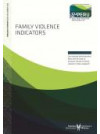Good quality, reliable outcome indicators can be used to monitor trends, identify emerging problems, create awareness, guide legislative and policy reforms, and ensure adequate provision of services.
This report assesses whether the administrative data sources collected by the Ministries of Health, Justice, Social Development (CYF) and the Police are suitable for providing outcome indicators to measure trends in the frequency of family violence events in the community.
The report recommends a provisional set of indicators as measures of trends in family violence as recorded by government agencies and also proposes a theoretical definition of family violence as a starting point for discussion. It also recommends ways to improve the quality of the data currently collected.
Methodology
Interviews were held with representatives of four government agencies: the New Zealand Police; the Ministry of Justice (which administers NZCASS); CYF; and the Ministry of Health.
The interviews allowed the research team to understand the data flow within each agency, and to determine the points of influence on the available data (such as the behaviour of practitioners, internal or external policy and targeted interventions). The agency representatives also directed the research team to policy and practice documents. These documents were reviewed to identify initiatives and/or policies that might have affected the content and quality of the data collected.
The administrative data sources were described and data flow process charts drawn up. The development of the charts for each agency was an iterative process, with agencies commenting on and clarifying successive drafts.
On the basis of the data sources, possible outcome indicators for family violence were suggested (Chapter 4). In Chapter 5 we examine the extent to which each of the possible indicators met the criteria for a good outcome indicator stipulated by Langley and Cryer (2000) and Measure Evaluation (2008). More detailed descriptions of our assessment of the criteria for each indicator are included in Appendix 1.
Key Results
Administrative data sources will always provide more information about service use than about the incidence and nature of family violence in the community. This is because only a small proportion of either victims or perpetrators will be identified by government agencies and thus captured by administrative data sets (United Nations, 2007). However, the appropriate use of measures derived from these data sets, properly interpreted on the basis of an understanding of the data sets from which they were drawn, can provide a description of how New Zealand government agencies are responding to some components of family violence.
This report proposes a number of recommendations to improve the quality of data that already exist in New Zealand. Implementation of these recommendations has the potential to improve service delivery and expand the possibilities for use of administrative data to provide outcome indicators. They include the following actions:
- The consistent use of terminology.
- A clear description of the variables contained in each data set that allows the extraction of data on family violence.
- Investigating the representativeness of the measures proposed.
- Investigating the possibility of generating more appropriate measures of intimate partner violence from the NZCASS.
- Collecting a core set of variables in each data set (Table 19).
- Regular staff training on the importance of good-quality data and the current standards for data collection within each agency.
Ideally, surveillance systems should be designed with the event of interest (in this case family violence) in mind (Guidelines Working Group, 2001). It follows that only population-based surveys will provide a true picture of the nature and extent of family violence in New Zealand. To be fully informative, such surveys should be designed and delivered with the safety of the respondent in mind, and conducted at regular intervals using consistent methods.

